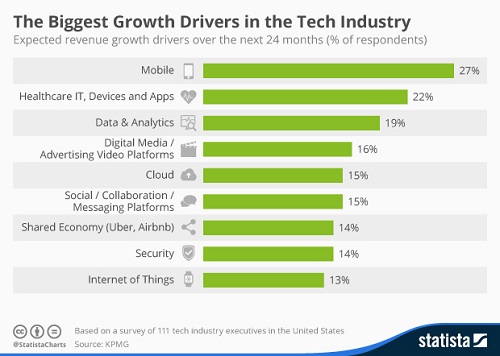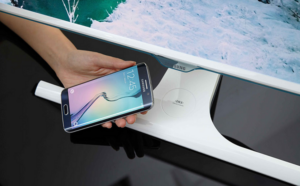We here at Meko publish two periodicals: Large Display Monitor, for anything larger than a notebook, and Mobile Display Monitor, for notebooks and anything smaller. Aside from these devices, there is little product crossover between the publications – ‘and never the twain shall meet’, as Kipling wrote.
However, with smartphones becoming more integrated into everyday life, that is changing quickly. Over the last few years, mobile devices have appeared in every pocket, and the trend continues. Among 111 executives of US technology firms (surveyed by KPMG), mobile was expected to be the biggest revenue growth driver over the next 24 months.
 Recently, we covered two interesting new desktop monitors from Eizo (Eizo Upgrades Gaming Features – Adds Bluetooth Adjustment) and Samsung (Samsung’s Wireless Charging Encourages Galaxy Use), which integrate with smartphones in new ways.
Recently, we covered two interesting new desktop monitors from Eizo (Eizo Upgrades Gaming Features – Adds Bluetooth Adjustment) and Samsung (Samsung’s Wireless Charging Encourages Galaxy Use), which integrate with smartphones in new ways.
Eizo’s monitor introduces a new version of the company’s G-Ignition software, called G-Ignition Mobile, which can be used to adjust display settings with a smartphone. It will also display an alert when a call or text is received.
As Bob writes in his comments to the article, on-screen displays have historically been a difficult area for monitor makers to get right. Adding touch to the process, through a smartphone, could be a low-cost way to simplify these adjustments – although Bluetooth has its own associated costs.
I talked to Colin Woodley, manager at Eizo UK, about the FS2735 and the convergence of the monitor and mobile markets. He noted that, several years ago, monitor makers and PC vendors were “all doom and gloom”, convinced that the release of the iPad meant that laptops were dead. Of course, that didn’t happen, but we have finally reached a time where mobile devices are having an impact on the design of larger displays.
The addition of G-Ignition Mobile to Eizo’s monitor could change the look of future models. For years, monitor makers have been pursuing the quest for thinner bezels – but when you slim the bezel down enough, where do you put the buttons? Locating them on the back or side means that multi-monitor users are punished. In the past, Foris monitors have had a dedicated remote control that replaced the physical buttons – but Woodley, speaking from personal experience, said that he was constantly losing his! In this situation, moving the control system to a smartphone, which will always be close to hand, makes more sense.
Other applications for such a monitor include control rooms, where the display is out of reach, or for users with disabilities.
Samsung has taken a different approach to Eizo; it has built a wireless charging pad into the base of its new SE370 monitor. The pad uses the Wireless Power Consortium’s Qi standard, which is supported on newer Galaxy smartphones – so, with this move, Samsung is pushing customers towards another of its product areas. Clever, eh?
We are living in a world where monitor makers – indeed, any consumer electronic vendor – can either ignore the massive global smartphone market, and fail, or embrace it and try to ride the wave. Aside from Samsung and Eizo, other companies have been moving in this direction for some time.
A prominent example, coming at the situation from the other direction, is Canonical. The Ubuntu Edge (Display Monitor Vol 20 No 29) was a smartphone that was the subject of the world’s largest-ever crowdfunding campaign, which aimed to reach $32 million (just under $13 million was raised, so the Edge never reached production). Canonical promised to put a PC in the phone, with a full desktop client and impressive specifications (4GB of RAM, 128GB of storage, dual-LTE connectivity). Connecting the phone to a display, via HDMI, enabled the desktop version of Ubuntu. Of course, without a mouse and keyboard you still had to control the system from the phone, but it was an interesting first step.
Microsoft has also “boarded the Convergence Express”, although in a different way from the above. Windows 10 is designed to make switching between devices easier, with a similar UI between phone, desktop and console. Apps are also shared between different versions.
All of these companies are preparing for the future, although there are some that have no plans to share. Several companies declined to be interviewed for this feature.
We don’t yet know what the future will look like, but mobiles will definitely be a part of it. The question is, how will larger screens tie in? – Tom Allen

